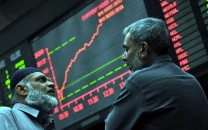Global bond prices double
Post IMF, investors express faith in economic reforms, timely debt repayment

Pakistan’s US dollar-denominated global Eurobonds and Sukuk have staged a powerful rally in recent days, suggesting the country has left behind the worst-case scenario of potential default on foreign debt repayments after achieving the International Monetary Fund (IMF) $3 billion loan programme in June 2023.
Global media outlet, Bloomberg, reported Pakistan’s international bonds would continue to hover high in 2024 ahead of the next IMF loan programme acquisition by the country after the current one completes in March 2024.

design: mohsin alam
Arif Habib Limited (AHL) reported the 10-year Pakistan Government International Bond worth $1 billion, maturing in April 2024, ended the trade at 94.7 cents/unit on Wednesday, which is more than double its price below 50 cents before the IMF programme in June 2023.
While talking to The Express Tribune; AHL, CEO, Shahid Ali Habib said the bond has bottomed out in June after the acquisition of the ongoing loan programme. Later on, the significant cut in the current account deficit in the first half of FY24 since the beginning of the year on July 1, 2023, energy and currency markets reforms, the successful completion of the first review of the domestic economy by the IMF in mid-November, and last but not least the return of stability in rupee-dollar parity; altogether extended their support in improving the country’s external economy and its capacity to make import payments and repay foreign debt on time, he said.
“All the developments improved foreign investors’ confidence in the domestic economy and invited huge interest in the country's rising Eurobonds and Sukuk in global markets,” he said.
Read PBC advocates long-term reforms in IMF negotiations
The price of Pakistan’s other Eurobonds and Sukuks also improved significantly in the past six months as well, including the 10-year bond worth $500 million maturing in September 2025. It has improved 74% in the past one year to 84.84 cents/unit on Wednesday, according to the research house. The 5-year bond worth $1.3 billion, maturing in April 2026, increased 72% to 70.56 cents. The 10-year bond worth $1.5 billion, maturing in December 2027, surged 71% to 67.62 cents. There are trading eight of Pakistan’s bonds in global markets worth totalling at $7.80 billion. They would mature from April 2024 to April 2051.
Citing investors in the country’s Eurobonds and Sukuks, Bloomberg projected “Pakistan’s dollar bonds will rally for a second year (in 2024) as the government is expected to secure another bailout from the International Monetary Fund.”
UBS Asset Management and William Blair Investment Management see its bonds remaining attractive after almost doubling in 2023. Suleman Rafiq Maniya, an independent wealth manager in Karachi, says gains can be as much as 37% in the next 18 months, it said.
Pakistan succeeded in averting a sovereign default after securing a $3 billion bailout from the IMF in July. The move catapulted the nation’s bonds to rank among the top performers in the world last year. While the gains are expected to moderate, reforms such as raising fuel and electricity prices may open the door for another round of funding.
“They seem committed to this IMF programme, and that is a significant point because it suggests there is a big likelihood for them to get another bailout,” said Johnny Chen, fund manager at William Blair in Singapore. “There is also strong potential for reforms to pick up momentum after the elections.”
Pakistan may seek a fresh loan from the Washington-based lender to nurse its fragile economy, interim finance minister Shamshad Akhtar said in November, reported the media outlet. AHL’s Habib further said the increase in the bond price ahead of its maturity in April 2024 strongly suggests global investors have full confidence in the government to make the due payments on time.
He recalled that State Bank of Pakistan (SBP) successfully paid over $1 billion to global investors against a Eurobond just days before it matured in December 2022. He hoped the government would succeed in acquiring a bigger and longer tenure IMF loan programme once the current one is completed in March 2024. He said the central bank has recently highlighted the domestic economy is showing early signs of recovery. This, along with the expected 4-5% cut in the central bank’s benchmark policy rate to 17-18% by the end of June 2024, will help in turning around the stabilising economy.
Published in The Express Tribune, January 4th, 2024.
Like Business on Facebook, follow @TribuneBiz on Twitter to stay informed and join in the conversation.



















COMMENTS
Comments are moderated and generally will be posted if they are on-topic and not abusive.
For more information, please see our Comments FAQ